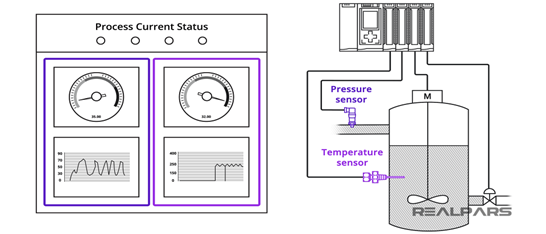What is a sensor?
A sensor is a device that senses something. Today we have sensors that can see, feel, hear, smell, and even taste.
Without sensors, our home and work lives would be quite difficult. For example, as you drive to work, the traffic lights at an intersection are controlled by sensors embedded in the road. These sensors detect your arrival at the intersection.
As you approach the grocery store, the door automatically opens because of a sensor.
In your plant, the batch process temperature and pressure are displayed and controlled as a result of output from Sensors.

Industrial sensors
In the world of instrumentation and process control, we define a Sensor as a device that detects changes in physical, electrical, or chemical properties and produces an electrical output in response to that change.

Types of sensors
What are the typical physical properties that sensors are detecting? Let’s name a few… Level, Temperature, Flow, Pressure, Speed, and Position.

Classification of sensors
From a process control perspective, we can classify sensors as either Passive or Active.
Passive sensors
A Passive Sensor requires an external source of power to operate while an Active Sensor does not.

Active sensors
A Thermocouple is an Active Sensor as it does not require any external power supply to operate.
Active sensors examples
As a thermocouple is exposed to an increase in temperature, it will develop an increasing voltage across it.

Another example of an Active sensor is a piezoelectric sensor.

Passive sensors examples
A Resistance Temperature Detector (RTD) is a Passive Sensor. It is a device that’s resistance will change with a change in temperature. To take advantage of this change in resistance, an external supply, or an excitation circuit is required to produce a change in voltage.

Another example of a Passive sensor is a Strain Gauge.

Sensors in the industry
Alright now that we’ve talked about different sensor types and the physical properties that they can sense, let’s discuss how they are used in the industry.
Almost every sensor used in process control will be connected to a Transmitter because a sensor’s output needs to be conditioned or amplified.
Here’s an example…We’ve already talked about a thermocouple and the voltage output created when it is heated. Unfortunately, the voltage output of a thermocouple is minuscule!
In our example, the thermocouple will produce a voltage output from 8 mV to 18 mV over a 450 degree Fahrenheit change in temperature!
In-process control, we condition that 8mV to 18mV thermocouple voltage and convert it to a 4 mA to 20 mA industry-standard signal that represents our controlled temperature range.


